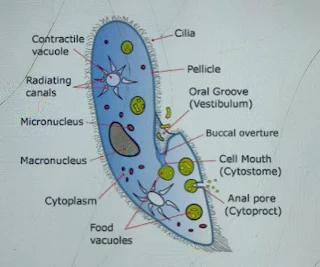Protozoa
- Introduction
- Amoeba
- E.Histolytica
- E.Gingivalis
- Giardia Lamblia
- Trichomonas Vaginalis
- Malaria Parasite
Introduction
General Characters of Protozoa
- It is a unicellular organism whose size varies from 1mm to 50mm.
- It is Heterotrophs
- It moves by means of Pseudopodae flagella, Chilia.
- These normally make their food through Phagocytosis.
- True cell wall is not found in.
- Most protozoa have single nucleus but some Protozoa are also multinucleated.
- It cell structure, mode of life , Reproduction is very complex.
- Most of the Reproduction is done by Binary Fission and Longitudinal fission.
- They contain contractile vacules for Osmo regulation
- Some Protozoa are also spherical oval and elongated.
- Some are also Photosynthetic.
- They study of Protozoa is called Protozoalogy.
 |
| Protozoa |
Classification of Protozoa
Protozoa parasite is divided into 4 parts on the basis of medical importance.
- Amoeba
- Flagellate
- Ciliate
- Sporozoa
1. Amoeba :- This type of parasite can change any shape through its Pseudopodia.
- Structurally are simple and have flagella absent.
- Medically important amoeba is divided into two parts.
- Amoeba of Almentary Canal
- Pathogenic free Living Amoeba
- These flagella are responsible for the locomotive.
- It causes systemic and local infection
- Parasites are divided into two parts on the basis of flagella.
- Kinetoplastida
- Flagella without Kinetoplastida
a. Kinetoplastida :- They are haemoflagellates which are transmitted and cause systemic and local infections.
 |
| Ciliate |
 |
| Sporozoa |


Comments
Post a Comment
Thanks to Come on Comment section